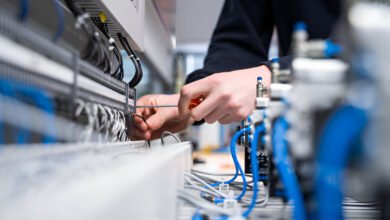What Is Polypropylene?
Polypropylene fabric is a type of thermoplastic polymer, meaning it becomes soft and moldable when heated and hardens upon cooling. It’s made from the polymerization of propylene, a byproduct of petroleum refining. Discovered in the 1950s, polypropylene quickly gained popularity due to its unique properties. Unlike many other plastics, it’s highly resistant to fatigue, meaning it can be bent repeatedly without breaking. This property, along with its flexibility and strength, makes it a versatile material suitable for a wide range of applications.
Common Uses of Polypropylene
Polypropylene’s unique combination of properties—such as durability, flexibility, and resistance to various chemicals—makes it a preferred material in many industries. Here’s a closer look at how it’s used:
Packaging
Polypropylene fabric is widely used in the packaging industry, especially for food containers, plastic bottles, and caps. Its non-toxic nature means it’s safe for storing food and beverages. It’s also resistant to moisture, which helps in keeping food fresh for longer periods. Its ability to withstand pressure and impact makes it ideal for packaging fragile items, ensuring they reach their destination without damage. As it is lighter than many other plastics, polypropylene reduces shipping costs and energy use during transportation, making it more eco-friendly in that regard.
Textiles
Polypropylene fibers are used in the production of various textiles, including activewear, thermal underwear, and ropes. These fibers are known for their ability to wick away moisture, making them ideal for athletic and outdoor clothing. In carpets and rugs, polypropylene fibers offer stain resistance and longevity, making them popular in both residential and commercial settings. Polypropylene fabric is also a key material in nonwoven fabrics, which are used in items like disposable diapers, masks, and wipes.
Automotive Parts
Polypropylene fabric is extensively used in the automotive industry for making parts like bumpers, interior trim panels, dashboards, and more. The material’s lightweight nature helps in reducing the overall weight of vehicles, which in turn improves fuel efficiency. Its resistance to heat makes it suitable for under-the-hood applications, where components need to withstand high temperatures without deforming. The affordability of polypropylene contributes to keeping manufacturing costs down, which is crucial in an industry where efficiency and cost management are key.
Medical Supplies
In the medical field, polypropylene fabric is used for items that need to be sterilized, such as syringes, pill bottles, and surgical trays. It can withstand the high temperatures of autoclaving without degrading, ensuring that medical tools remain safe and sterile. Many disposable medical products, such as masks, gloves, and gowns, are made from polypropylene. This is because it’s cheap to produce, lightweight, and provides a good barrier against contaminants. Polypropylene’s resistance to many chemicals ensures that it doesn’t react with medications or cleaning agents, maintaining the safety and efficacy of medical supplies.
Why Is Polypropylene Important?
Polypropylene’s importance stems from its combination of beneficial properties, which make it one of the most widely used plastics today. Here’s why it’s so crucial:
Durability
Products made from polypropylene fabric can last a long time, even under stress. This durability is essential for items that are subjected to regular wear and tear, such as packaging materials, automotive components, and textiles. The material’s ability to absorb shock without cracking makes it ideal for applications where durability is a priority, like in automotive parts and protective gear.
Lightweight
The lightweight nature of polypropylene reduces the overall weight of products, which is particularly beneficial in industries like automotive and packaging. This reduction in weight translates to lower transportation costs and less fuel consumption, making the supply chain more efficient. For consumers, lightweight products are easier to handle and use, adding to the material’s appeal in consumer goods.
Cost-Effective
Polypropylene fabric is inexpensive to produce, which is why it’s so widely used in cost-sensitive industries. Its low production cost helped manufacturers keep prices down, making products more affordable for consumers. Because it is so versatile and affordable, polypropylene plays a significant role in various industries, contributing to economic growth and innovation.
Recyclable
One of the key advantages of polypropylene is that it’s recyclable. After its initial use, polypropylene can be melted down and reformed into new products, reducing the need for virgin plastic production and lessening the environmental impact. While recyclable, polypropylene still faces challenges in recycling, such as the need for proper sorting and cleaning. However, advancements in recycling technology are gradually improving the efficiency and effectiveness of polypropylene recycling.
Environmental Impact of Polypropylene
Polypropylene, like all plastics, has an environmental footprint. While it offers many benefits, it’s important to consider its environmental impact:
- Pollution Concerns: If not properly disposed of, polypropylene can contribute to plastic pollution, particularly in oceans and waterways. Non-recycled polypropylene products can take hundreds of years to decompose, during which time they can break down into microplastics that harm marine life.
- Recycling Efforts: On the positive side, polypropylene’s recyclability offers a way to mitigate its environmental impact. More and more facilities are able to recycle polypropylene, turning it into new products and reducing the need for new plastic production.
- Sustainable Practices: Manufacturers are increasingly exploring ways to reduce the environmental impact of polypropylene by using recycled material in production and developing biodegradable alternatives.
Polypropylene is a crucial material in modern life, providing a blend of strength, flexibility, and affordability that makes it suitable for a wide range of applications. From packaging and textiles to automotive parts and medical supplies, this versatile plastic is everywhere. While it offers many advantages, it’s also important to be mindful of its environmental impact and to support recycling efforts wherever possible. Understanding polypropylene helps us make informed choices about the products we use and their impact on the world around us.



